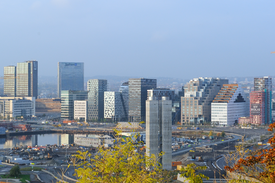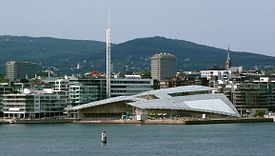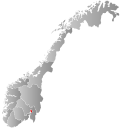Christiana, Norway
| Oslo | ||||||||
|---|---|---|---|---|---|---|---|---|
| City | ||||||||
From upper left: Barcode at Bjørvika, Stortinget, Akershus Castle, Astrup Fearnley Museum at Tjuvholmen, Briskeby Line at Uranienborg, Royal Palace
|
||||||||
|
||||||||
| Motto: Unanimiter et constanter (Latin: United and constant) |
||||||||
| Coordinates: 59°57′N 10°45′E / 59.950°N 10.750°ECoordinates: 59°57′N 10°45′E / 59.950°N 10.750°E | ||||||||
| Country | Norway | |||||||
| District | Østlandet | |||||||
| County | Oslo | |||||||
| Established | 1048 | |||||||
| Government | ||||||||
| • Mayor | Marianne Borgen (SV) | |||||||
| • Governing mayor | Raymond Johansen (AP) | |||||||
| Area | ||||||||
| • City | 480.76 km2 (185.62 sq mi) | |||||||
| • Land | 454.08 km2 (175.32 sq mi) | |||||||
| • Water | 26.68 km2 (10.30 sq mi) | |||||||
| Elevation | 23 m (75 ft) | |||||||
| Population (January 1, 2016) | ||||||||
| • City | 658,390 | |||||||
| • Density | 1,400/km2 (3,500/sq mi) | |||||||
| • Urban | 942,084 | |||||||
| • Metro | 1,717,900 | |||||||
| Ethnic groups | ||||||||
| • Norwegian | 71.5% | |||||||
| • Pakistani | 3.6% | |||||||
| • Swedish | 2.2% | |||||||
| • Somali | 2.0% | |||||||
| • Polish | 1.7% | |||||||
| Time zone | CET (UTC+1) | |||||||
| • Summer (DST) | CEST (UTC+2) | |||||||
| Postal code | 0001 – 1299 | |||||||
| Area code(s) | (+47) 00 | |||||||
| Website | www |
|||||||
| Oslo kommune | |||
|---|---|---|---|
| Municipality | |||
|
|||
 Oslo surrounded by Akershus county |
|||
| Country | Norway | ||
| County | Oslo | ||
| Time zone | CET (UTC+1) | ||
| • Summer (DST) | CEST (UTC+2) | ||
| ISO 3166 code | NO-0301 | ||
| Official language form | Neutral | ||
|
|
|||
|
Oslo timeline (major events) See also expanded timeline |
|
|---|---|
| CA. 1000 AD | First traces of buildings. The St. Clement's Church is built. |
| CA. 1050 AD | Oslo marked as a city. Mariakirken is built. |
| 1152/53 AD | The Cathedral school is established |
| 1299 AD | Oslo becomes the capital of Norway |
| CA. 1300 | Construction of Akershus Fortress starts. |
| 1350 AD | Around 3/4 of the population dies under the Black Death. |
| 1352 AD | St. Hallvard's Cathedral and the other Sogne Churches are burned to the ground in a major fire |
| 1624 AD | Another major fire, the city is rebuilt and renamed Christiania by Christian IV. |
| 1686 AD | Fire ruins 1/4 of the city. |
| 1697 AD | Domkirken is finished and opened |
| 1716 AD | The city and the fortress conquered by Karl XII. |
| 1813 | The University is opened. |
| 1825 | The foundations of Slottet are finished. |
| 1836 | The National Gallery is finished. |
| 1837 | Christiania Theatre is opened. Christiania and Aker get a Mayor and kommunestyre. |
| 1854 | Oslo gets its first railway, which leads to Eidsvoll. |
| 1866 | Stortinget is completed. |
| 1878 | City expanded. Frogner, Majorstuen, Torshov, Kampen and Vålerengen are populated and rebuilt. 113 000 citizens. |
| 1892 | The first Holmenkollbakken is finished. |
| 1894 | The city gets its first electrical track. |
| 1899 | Nationaltheateret is finished. |
| 1925 | City renamed as Oslo. |
| 1927 | The Monolith is raised. |
| 1928 | Oslo first Metro line, Majorstuen-Besserud is opened. |
| 1950 | Oslo City Hall opened. |
| 1963 | The Munch Museum is opened. |
| 1980 | Metro line under the city, Oslo Central Station and Nationaltheatret Station opened. |
| 1997 | Population over 500 000. |
| 1998 | Rikshospitalet opened. New railway line to Gardermoen. |
| 2000 | The city celebrates thousand-years jubilee. |
| 2008 | Oslo Opera House is opened. |
| 2011 | Several buildings in the Regjeringskvartalet are heavily damaged during a terrorist attack, resulting in 8 deaths. 69 people are massacred on the nearby Utøya island. |
| Number of minorities (1st and 2nd gen.) in Oslo by country of origin in 2015 |
|
| Nationality | Population (2015) |
|---|---|
|
|
22,864 |
|
|
15,862 |
|
|
13,911 |
|
|
13,789 |
|
|
7,854 |
|
|
7,272 |
|
|
6,569 |
|
|
6,397 |
|
|
6,192 |
|
|
6,164 |
|
|
5,917 |
|
|
5,246 |
|
|
3,777 |
|
|
3,678 |
|
|
3,607 |
Oslo (English pronunciation: /ˈɒzloʊ/, OZ-loh,Norwegian pronunciation: [²uʂlu] (![]() listen) or, rarer [²uslu] or [ˈuʂlu]) is the capital and the most populous city in Norway. It constitutes both a county and a municipality. Founded in the year 1040, and established as a kaupstad or trading place in 1048 by Harald Hardrada, the city was elevated to a bishopric in 1070 and a capital under Haakon V of Norway around 1300. Personal unions with Denmark from 1397 to 1523 and again from 1536 to 1814 and with Sweden from 1814 to 1905 reduced its influence. After being destroyed by a fire in 1624, the city was moved closer to Akershus Fortress during the reign of Christian IV of Denmark and renamed Christiania in his honour. It was established as a municipality (formannskapsdistrikt) on 1 January 1838. Following a spelling reform, it was known as Kristiania from 1877 to 1925, at which time its original Norwegian name was restored.
listen) or, rarer [²uslu] or [ˈuʂlu]) is the capital and the most populous city in Norway. It constitutes both a county and a municipality. Founded in the year 1040, and established as a kaupstad or trading place in 1048 by Harald Hardrada, the city was elevated to a bishopric in 1070 and a capital under Haakon V of Norway around 1300. Personal unions with Denmark from 1397 to 1523 and again from 1536 to 1814 and with Sweden from 1814 to 1905 reduced its influence. After being destroyed by a fire in 1624, the city was moved closer to Akershus Fortress during the reign of Christian IV of Denmark and renamed Christiania in his honour. It was established as a municipality (formannskapsdistrikt) on 1 January 1838. Following a spelling reform, it was known as Kristiania from 1877 to 1925, at which time its original Norwegian name was restored.
...
Wikipedia









